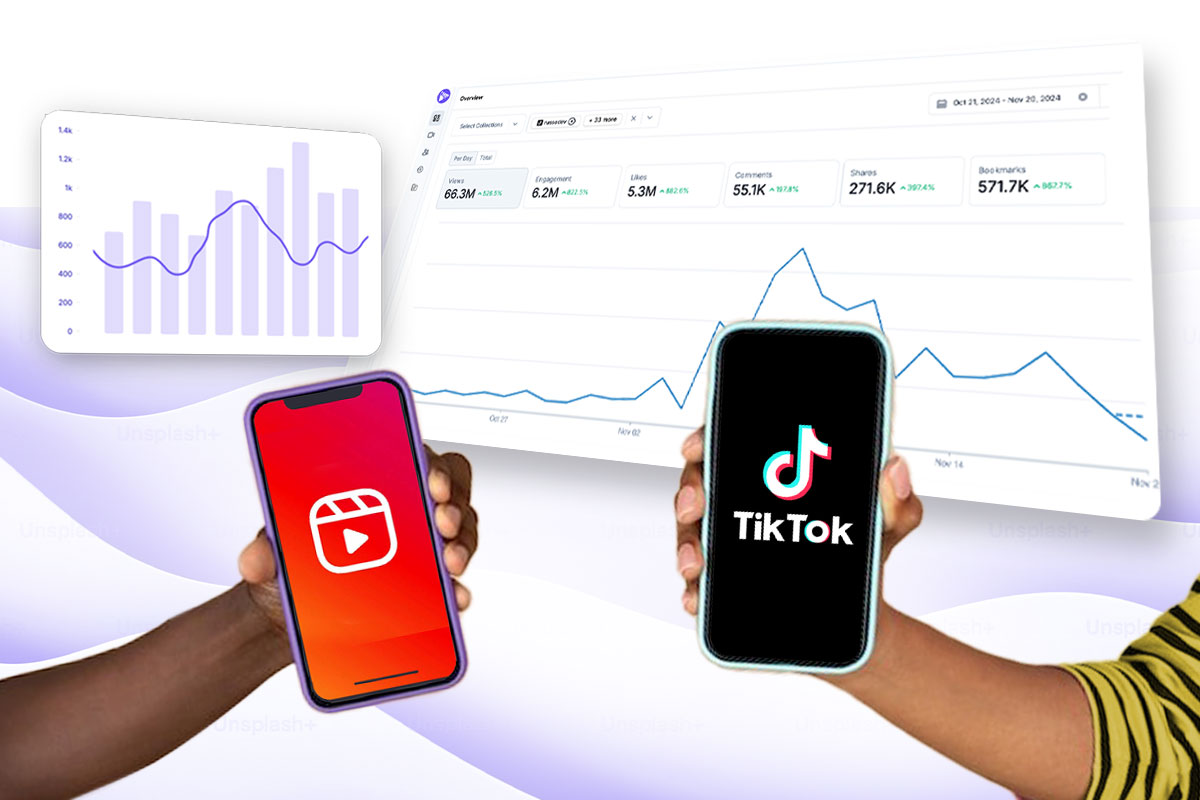The rise of short-form video content has revolutionized how brands engage with their audiences. Instagram Reels and TikTok currently dominate this space, offering huge opportunities for organic growth, visibility, and community building. However, being good at leveraging these platforms requires more than just creative content—it calls for a strong strategic analysis. By comparing data from Instagram Reels and TikTok accounts, you can uncover actionable insights, optimize your strategies, and maximize your cross-platform success.
In this post, we’ll learn how to analyze Instagram Reels as we analyze TikTok accounts side-by-side to create a cohesive approach to short-form content success and virality.
Why Cross-Platform Analysis Matters
We all know that short-form content thrives on trends, algorithms, and user engagement. While Instagram Reels and TikTok share some similarities, they cater to different audiences, and their algorithms prioritize content in a different way. If you don’t understand how performance differs across these platforms, your brand might be at risk for inconsistent messaging and missed opportunities.
Cross-platform analysis enables brands to:
Understand Audience Preferences: Identify what resonates with audiences on each platform.
Optimize Content Strategy: Tailor content to align with platform-specific trends and user behaviors.
Measure ROI: Compare engagement, reach, and conversions to determine which platform delivers better results.
Key Metrics to Track
To analyze TikTok accounts and Instagram Reels effectively, you should start by focusing on the following metrics:
1. Engagement Metrics
- TikTok: Likes, comments, shares, and average watch time.
- Instagram Reels: Likes, comments, saves, and shares.
Engagement on TikTok often stems from trends and virality, while Instagram Reels benefits mostly from audience loyalty and consistent posting. Comparing these metrics helps identify where your content sparks the most interaction.
2. Reach and Impressions
- TikTok: Total video views and follower growth.
- Instagram Reels: Reach, impressions, and non-follower views.
You can use these metrics to determine how well your content is being discovered by new audiences. TikTok’s algorithm favors viral moments, while Instagram rewards creators who drive interactions among their existing followers.
3. Audience Demographics
- TikTok: Age, gender, location, and active hours.
- Instagram Reels: Similar demographic breakdowns with additional insights into follower behaviors.
Demographic insights allow you to get more information on how to properly tailor your messaging. For instance, if TikTok skews younger for your brand while Instagram reaches a more diverse age range, so having this in mind, you can adapt your tone and style accordingly.
4. Conversion Metrics
- TikTok: Link clicks, purchases, or app installs from your bio or ads.
- Instagram Reels: Website clicks, product views, and direct messages.
By tracking conversions, you can measure which platform actually drives the most tangible business outcomes such as sales and leads.
Tools to Simplify Cross-Platform Analysis
The issue with tracking data manually is that it is extremely time-consuming and prone to errors. Good news is that you can leverage analytics tools to streamline the process:
Native Analytics Platforms
- TikTok Analytics: Provides in-depth insights on video performance, audience, and trends.
- Instagram Insights: Offers data on engagement, reach, and content interactions.
While these are widely used by everyone, relying on these native tools alone will always require manual comparison and take more time and effort to provide actionable points.
Third-Party Tools
Shortimize
Allows side-by-side comparisons of Instagram and TikTok metrics. You can use it to track simultaneously all of your short-form accounts, which means that you’ll get standardized metrics that facilitate analysis and the whole decision-making process.
Sprout Social
Offers detailed reports on audience growth and content performance across platforms.
Social Blade
Tracks follower trends, engagement rates, and estimated earnings for both platforms.
Custom Dashboards
You can always choose to export data into tools like Excel, Google Sheets, or Tableau to create custom reports tailored to your specific KPIs.
With Shortimize, you can request access to an API which allows you to build any custom dashboards on top of your multi-account data directly.
Steps to Analyze Instagram Reels and TikTok Side-by-Side
1. Define Your Goals
Before getting straight into the data, clarify your objectives. Are you aiming to grow your audience, increase engagement, or drive sales? Having clear goals ensures you focus on the metrics that matter instead of wasting time on the ones that don’t matter as much.
2. Collect Data
Extract performance metrics from TikTok Analytics and Instagram Insights. Consolidate this data into a unified format for easy comparison.
Example:
| Metric | TikTok | Instagram Reels |
| Average Engagement | 12% | 8% |
| Reach (Last Month) | 500,000 | 300,000 |
| Follower Growth | +5,000 | +2,000 |
3. Identify Trends
Look for patterns in performance. Are certain content types (e.g., tutorials, humor, or inspirational stories) outperforming others? Analyze how these trends vary by platform so that you can start drawing conclusions on what kind of content is performing and which isn’t.
4. Compare Content Performance
Evaluate which platform drives better results for specific types of content. For instance:
- TikTok may excel with raw, unpolished videos that align with viral trends.
- Instagram Reels might perform better with polished, aesthetically pleasing content.
What works in one platform might not necessarily be what goes viral in another.
5. Adjust Strategies
Use your findings to refine your approach. For example, if TikTok videos are generating higher reach but lower conversions, integrate stronger calls to action. If Reels are driving more website clicks, double down on promotional content tailored to Instagram’s audience.
Challenges in Cross-Platform Analysis
1. Differing Algorithms
TikTok’s algorithm prioritizes virality, while Instagram’s rewards engagement and retention. Comparing the two requires accounting for these differences.
Solution: Focus on outcome-driven metrics like conversions or audience retention rather than raw views.
2. Inconsistent Metrics
Metrics like “shares” or “comments” may mean different things on each platform.
Solution: Standardize your metrics by calculating engagement rates or cost-per-engagement across both platforms, or use a third-party tool like Shortimize to streamline your data into standardized metrics.
3. Overlapping Audiences
Some followers may engage with your brand on both platforms, skewing metrics like reach and impressions.
Solution: Use tools like Google Analytics to track unique traffic sources and conversions from each platform.
Tips for Cross-Platform Content Success
Diversify Content: Avoid posting identical content on both platforms. Tailor your videos to fit each platform’s audience and algorithm.
Leverage Trends Wisely: TikTok trends can inspire Reels content, but always adapt them to Instagram’s more curated aesthetic.
Test and Iterate: Experiment with different formats, hashtags, and posting times to determine what works best on each platform.
Engage Authentically: Both platforms reward genuine interaction. Respond to comments, participate in challenges, and stay active within your niche.
Final Thoughts
Mastering cross-platform success requires more than just creating engaging content; it demands a data-driven approach to understand what works, why, and where. By learning to analyze TikTok accounts and Instagram Reels, brands can really grasp the unique strengths of each platform to build a cohesive, impactful presence in the world of short-form video.



